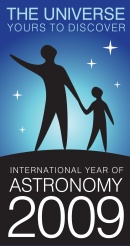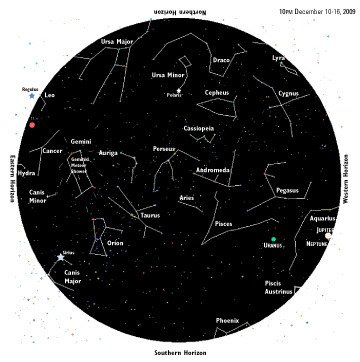Chesapeake Bay's Independent Newspaper ~ Since 1993
1629 Forest Drive, Annapolis, MD 21403 ~ 410-626-9888
Volume XVII, Issue 50 ~ December 10 - December 16, 2009
Home \\ Correspondence \\ from the Editor \\ Submit a Letter \\ Classifieds \\ Contact Us
Dining Guide \\ Home & Garden Guide \\ Archives \\ Distribution Locations \\ Advertising
![]()



Sky Watch

by J. Alex Knoll
Crawling at 22 Miles a Second
Slow by meteor standards, the Geminids put on
quite a show
Mercury appears as a surprisingly bright light low in the west after sunset, around 4:45. You’re most likely to spot it with binoculars against the glare of the horizon, as it sets within a half-hour of the sun.
Jupiter rules our evening skies, appearing high in the south as the sun sets around 4:45, then arcing westward and setting by 10pm.
As Jupiter sets in the southwest, Mars rises in the northeast. By midnight the red planet is high in the east, not to be confused with blue-white Regulus, the heart of Leo the lion, trailing 10 degrees — the width of your fist extended at arm’s length. Until moonrise, Mars outshines all other objects except Sirius the dog star, which blazes an intense ice-blue far to the south.
Around 1am, Saturn crests the east horizon, far behind Mars and only half as bright. Twenty degrees to the east twinkles Spica, a noticeably brighter than the ringed planet. By 7am, Saturn is high in the south and only to disappear with sunrise, after 7:15 this week.
The waning crescent moon travels through pre-dawn skies this week, shining just a few degrees below twinkling Spica early Friday morning.
Two days from new phase, the moon is well out of the picture Sunday night and Monday morning, the peak of this year’s Geminid meteor shower. Seeming to emanate from the bright star Castor in its namesake constellation, this is the Old Faithful of meteor showers. Away from city lights, you could see as many as 100 meteors each hour, and even amid the urban glare, you might spot 10 to 20 each hour. Compared to other meteor showers, the Geminids are slow-moving, hitting Earth’s atmosphere at 22 miles per second, which causes them to leave long, glowing trails in their wake. While not as active after the peak, keep your eyes open for errant meteors through the week.
Illustration: © Copyright 1925 M.C. Escher/Cordon Art-Baarn-Holland; Graphics: © Copyright 2009 Pacific Publishers. Reprinted by permission from the Tidelog graphic almanac. Bound copies of the annual Tidelog for Chesapeake Bay are $14.95 ppd. from Pacific Publishers, Box 480, Bolinas, CA 94924. Phone 415-868-2909. Weather affects tides. This information is believed to be reliable but no guarantee of accuracy is made by Bay Weekly or Pacific Publishers. The actual layout of Tidelog differs from that used in Bay Weekly. Tidelog graphics are repositioned to reflect Bay Weekly’s distribution cycle.Tides are based on National Oceanic and Atmospheric Administration and are positioned to coincide with high and low tides of Tidelog.
© COPYRIGHT 2009 by New Bay Enterprises, Inc. All rights reserved.
